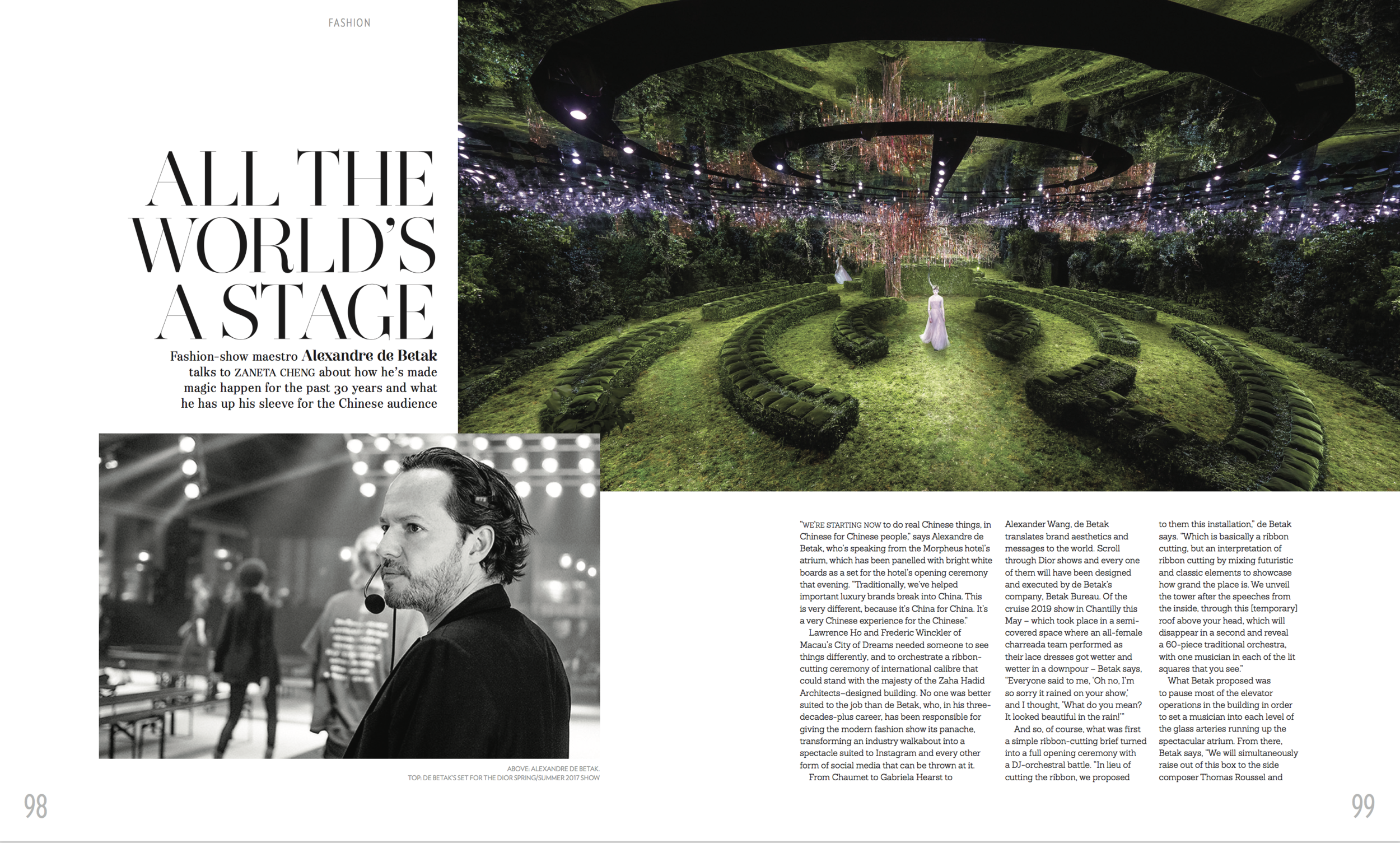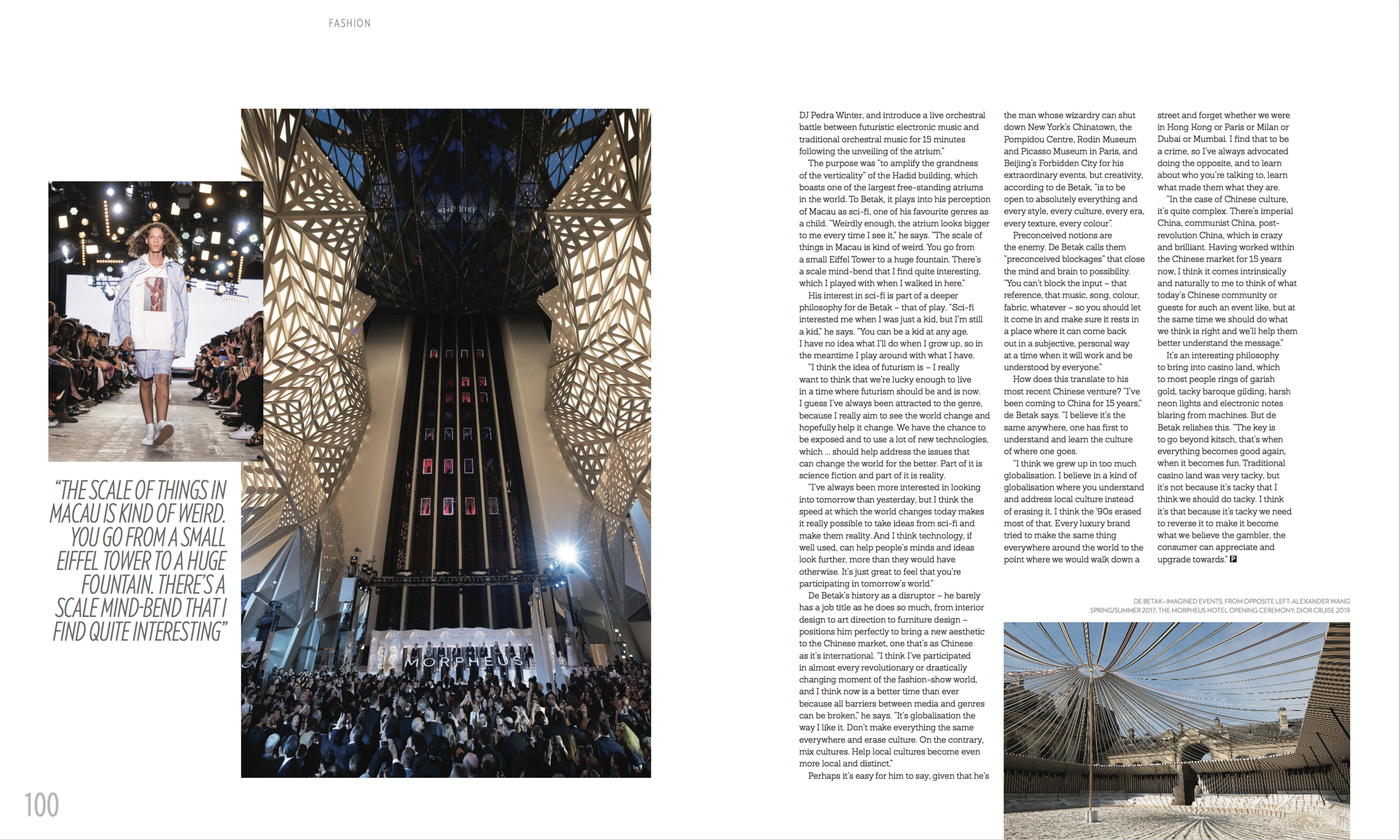Alexandre de Betak | Prestige Hong Kong (Sept 18)
Fashion-show maestro Alexandre de Betak talks to zaneta cheng about how he’s made magic happen for the past 30 years and what he has up his sleeve for the Chinese audience
“We’re starting now to do real Chinese things, in Chinese for Chinese people,” says Alexandre de Betak, who’s speaking from the Morpheus hotel’s atrium, which has been panelled with bright white boards as a set for the hotel’s opening ceremony that evening. “Traditionally, we’ve helped important luxury brands break into China. This
is very different, because it’s China for China. It’s a very Chinese experience for the Chinese.”
Lawrence Ho and Frederic Winckler of Macau’s City of Dreams needed someone to see things differently, and to orchestrate a ribbon-cutting ceremony of international calibre that could stand with the majesty of the Zaha Hadid Architects–designed building. No one was better suited to the job than de Betak, who, in his three-decades-plus career, has been responsible for giving the modern fashion show its panache, transforming an industry walkabout into a spectacle suited to Instagram and every other form of social media that can be thrown at it.
From Chaumet to Gabriela Hearst to Alexander Wang, de Betak translates brand aesthetics and messages to the world. Scroll through Dior shows and every one of them will have been designed and executed by de Betak’s company, Betak Bureau. Of the cruise 2019 show in Chantilly this May – which took place in a semi-covered space where an all-female charreada team performed as their lace dresses got wetter and wetter in a downpour – Betak says, “Everyone said to me, ‘Oh no, I’m so sorry it rained on your show,’ and I thought, ‘What do you mean? It looked beautiful in the rain!’”
And so, of course, what was first a simple ribbon-cutting brief turned into a full opening ceremony with a DJ-orchestral battle. “In lieu of cutting the ribbon, we proposed to them this installation,” de Betak says. “Which is basically a ribbon cutting, but an interpretation of ribbon cutting by mixing futuristic and classic elements to showcase how grand the place is. We unveil the tower after the speeches from the inside, through this [temporary] roof above your head, which will disappear in a second and reveal a 60-piece traditional orchestra, with one musician in each of the lit squares that you see.”
What Betak proposed was to pause most of the elevator operations in the building in order to set a musician into each level of the glass arteries running up the spectacular atrium. From there, Betak says, “We will simultaneously raise out of this box to the side composer Thomas Roussel and DJ Pedra Winter, and introduce a live orchestral battle between futuristic electronic music and traditional orchestral music for 15 minutes following the unveiling of the atrium.”
The purpose was “to amplify the grandness of the verticality” of the Hadid building, which boasts one of the largest free-standing atriums in the world. To Betak, it plays into his perception of Macau as sci-fi, one of his favourite genres as a child. “Weirdly enough, the atrium looks bigger to me every time I see it,” he says. “The scale of things in Macau is kind of weird. You go from a small Eiffel Tower to a huge fountain. There’s a scale mind-bend that I find quite interesting, which I played with when I walked in here.”
His interest in sci-fi is part of a deeper philosophy for de Betak – that of play. “Sci-fi interested me when I was just a kid, but I’m still a kid,” he says. “You can be a kid at any age. I have no idea what I’ll do when I grow up, so in the meantime I play around with what I have.
“I think the idea of futurism is --– I really want to think that we’re lucky enough to live
in a time where futurism should be and is now. I guess I’ve always been attracted to the genre, because I really aim to see the world change and hopefully help it change. We have the chance to be exposed and to use a lot of new technologies, which ... should help address the issues that can change the world for the better. Part of it is science fiction and part of it is reality.
“I’ve always been more interested in looking into tomorrow than yesterday, but I think the speed at which the world changes today makes
it really possible to take ideas from sci-fi and make them reality. And I think technology, if
well used, can help people’s minds and ideas look further, more than they would have otherwise. It’s just great to feel that you’re participating in tomorrow’s world.”
De Betak’s history as a disruptor – he barely has a job title as he does so much, from interior design to art direction to furniture design – positions him perfectly to bring a new aesthetic to the Chinese market, one that’s as Chinese as it’s international. “I think I’ve participated in almost every revolutionary or drastically changing moment of the fashion-show world, and I think now is a better time than ever because all barriers between media and genres can be broken,” he says. “It’s globalisation the way I like it. Don’t make everything the same everywhere and erase culture. On the contrary, mix cultures. Help local cultures become even more local and distinct.”
Perhaps it’s easy for him to say, given that he’s the man whose wizardry can shut down New York’s Chinatown, the Pompidou Centre, Rodin Museum and Picasso Museum in Paris, and Beijing’s Forbidden City for his extraordinary events, but creativity, according to de Betak, “is to be open to absolutely everything and every style, every culture, every era, every texture, every colour”.
Preconceived notions are the enemy. De Betak calls them “preconceived blockages” that close the mind and brain to possibility. “You can’t block the input – that reference, that music, song, colour, fabric, whatever – so you should let it come in and make sure it rests in
a place where it can come back out in a subjective, personal way at a time when it will work and be understood by everyone.”
How does this translate to his most recent Chinese venture? “I’ve been coming to China for 15 years,” de Betak says. “I believe it’s the same anywhere, one has first to understand and learn the culture of where one goes.
“I think we grew up in too much globalisation. I believe in a kind of globalisation where you understand and address local culture instead of erasing it. I think the ’90s erased most of that. Every luxury brand tried to make the same thing everywhere around the world to the point where we would walk down a street and forget whether we were in Hong Kong or Paris or Milan or Dubai or Mumbai. I find that to be a crime, so I’ve always advocated doing the opposite, and to learn about who you’re talking to, learn what made them what they are.
“In the case of Chinese culture, it’s quite complex. There’s imperial China, communist China, post-revolution China, which is crazy and brilliant. Having worked within the Chinese market for 15 years now, I think it comes intrinsically and naturally to me to think of what today’s Chinese community or guests for such an event like, but at the same time we should do what we think is right and we’ll help them better understand the message.”
It’s an interesting philosophy to bring into casino land, which to most people rings of garish gold, tacky baroque gilding, harsh neon lights and electronic notes blaring from machines. But de Betak relishes this. “The key is to go beyond kitsch, that’s when everything becomes good again, when it becomes fun. Traditional casino land was very tacky, but it’s not because it’s tacky that I think we should do tacky. I think it’s that because it’s tacky we need to reverse it to make it become what we believe the gambler, the consumer can appreciate and upgrade towards.”

